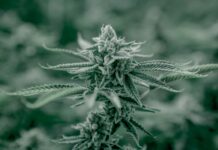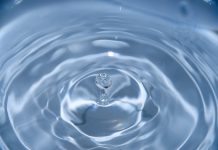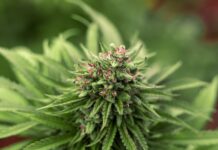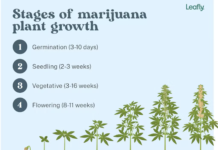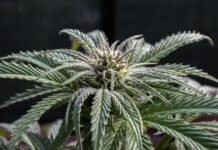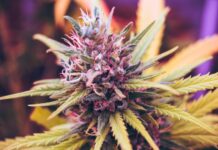Table of Contents :
Lighting is 1 of 4 success factors
Light is one of the most important growth factors in cannabis cultivation. There are four light factors affecting your cannabis crop:
- amount of light (light intensity)
- light duration
- light quality (spectrum)
- distribution (luminosity).
If you optimize these four factors, you will increase the crop’s productivity, plant quality and yield.
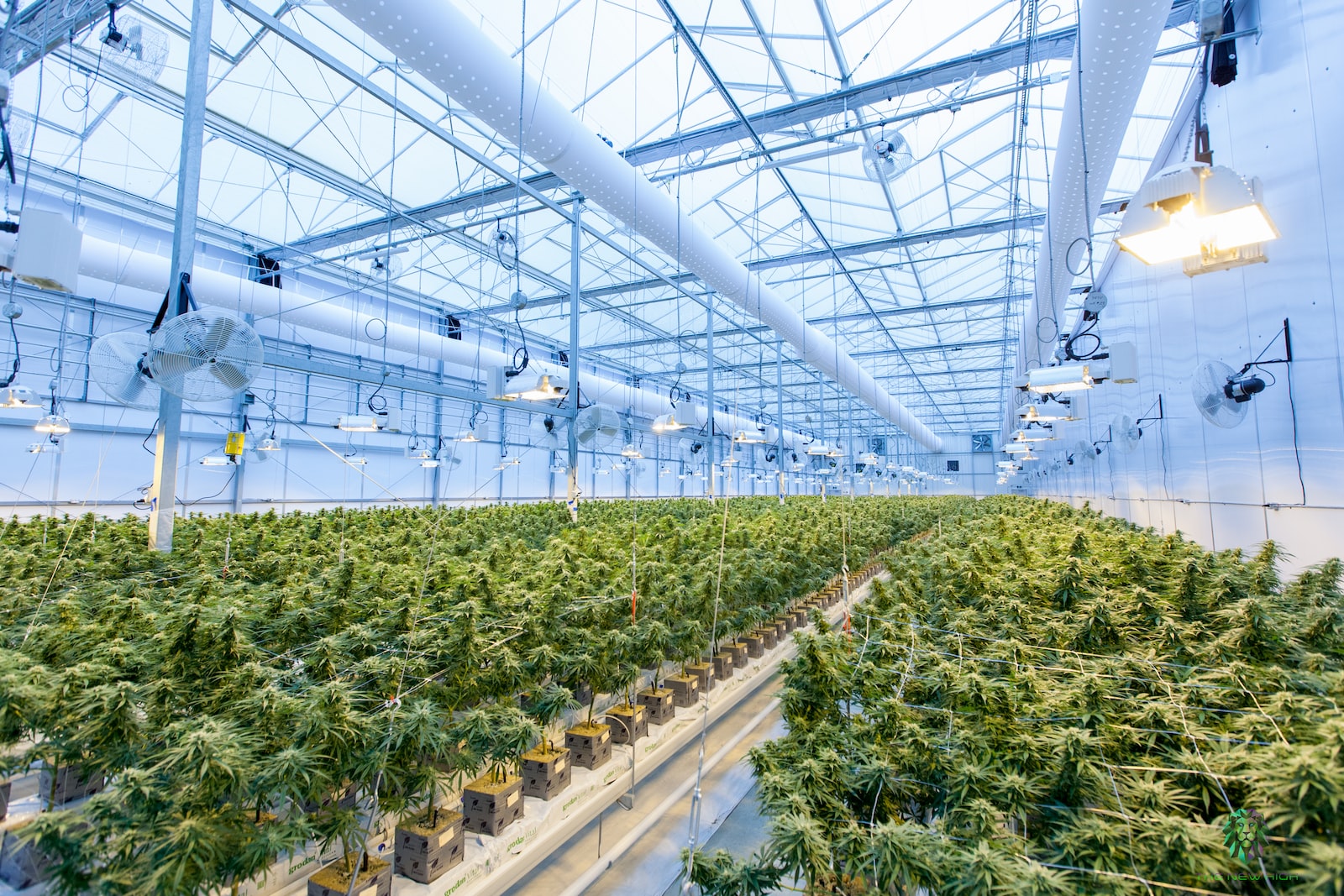
Light duration
How many hours of light your plant gets each day affects how much it grows. The more hours of light each day, the more the plant grows. For that reason, it is common to give cannabis plants 16 hours of light and 8 hours of darkness until the end of the vegetative fase. For a cannabis plant to flower (does not apply to autoflower), the plant must receive 12 hours of darkness every day. At the end of the vegetative period, we therefore reduce the number of light hours each day from 16 to 12 hours.
- Germination stage – 24 hours light / 0 hours darkness
- Seedling stage – 18 hours light / 8 hours darkness
- Vegetative stage – 18 hours light / 8 hours darkness
- Flowering stage – 12 hours light / 12 hours darkness
Light intensity
Light intensity is directly linked to yield. The greater the light intensity, the greater the dry weight of the blossoms. Which gives a bigger crop.
The rule of thumb for light intensity is that a 1% increase in light corresponds to a 0.5-1% increase in harvestable product. In a study from Wageninen University, they discovered that this was true for all horticultural crops they evaluated. You get the greatest effect when you increase the light intensity in an environment with low light levels, high CO2 levels and high temperatures. It appears that cannabis yield will increase linearly with increasing PPFDs up to 1400umol/m2/s. If the level is higher, the plant may receive too much light and suffer light damage (burning) (NCBI, 2018).
How to measure light for plants ?
To describe the light intensity, we use three terms: PAR, PPFD and LUX.
- PAR (Photosynthetically Active Radiation) describes the portion of the visible spectrum that plants “see” and use for photosynthesis (400nm-700nm).
- PPFD (Photosynthetic Photon Flux Density) measures the amount of light (PAR) a plant receives over time. PPFD represents the light density a plant receives over time and is measured in micromoles [of photons] per square meter per second.
- LUX – One lux is equal to one lumen per square metre. One lux is also equal to 0.0929 foot-candle. The more lux, the more light.
These recommendations apply to cannabis lighting for the different stage of life cycle:
- Seedlings and cuttings: 5.000 – 10.000 lux
- Vegetative growth: 15.000 – 50.000 lux
- Flowering: 50.000 – 75.000 lux
Does the plant produce THC to protect itself from light ?
It has been suggested that cannabis resin has a protective sunscreen function to protect the plant from sunlight. The theory is that the higher the light intensity, the more THC the plant will produce to protect itself from the damage strong sunlight can cause. However, studies show that the glands and the secreted resin accumulate on the lower leaf surface rather than the upper surface and in the perigonial bracts of the flower most exposed to sunlight. The theory therefore does not seem to agree with actual conditions. TCH is not produced to protect the plant from strong sunlight (NCBI, 2018).
The studies by Vanhove and Potter and Duncombe concluded that THC concentrations in the cannabis flower are primarily influenced by the cannabis gene and not light and cultivation method (NCBI, 2018).
Light quality (spectrum)
The light quality does not affect the yield you get from the cannabis plant, but the light quality seems to affect the cannabinoid synthesis that produces THC and CDB, among other things.
The light spectrum refers to the range of wavelengths produced by a light source. Humans can see light that has a wavelength (electromagnetic spectrum) of between 380–740 nanometers (nm). We perceive this as variations in blue, green, yellow and red light. We perceive light that is 400nm as violet light and light that is 700nm as red. When the entire spectrum of visible light is combined, we see it as white light.
Ultraviolet (100–400 nm), far red (700–850 nm) and infrared (700–10 6 nm) wavelengths are referred to as radiation.
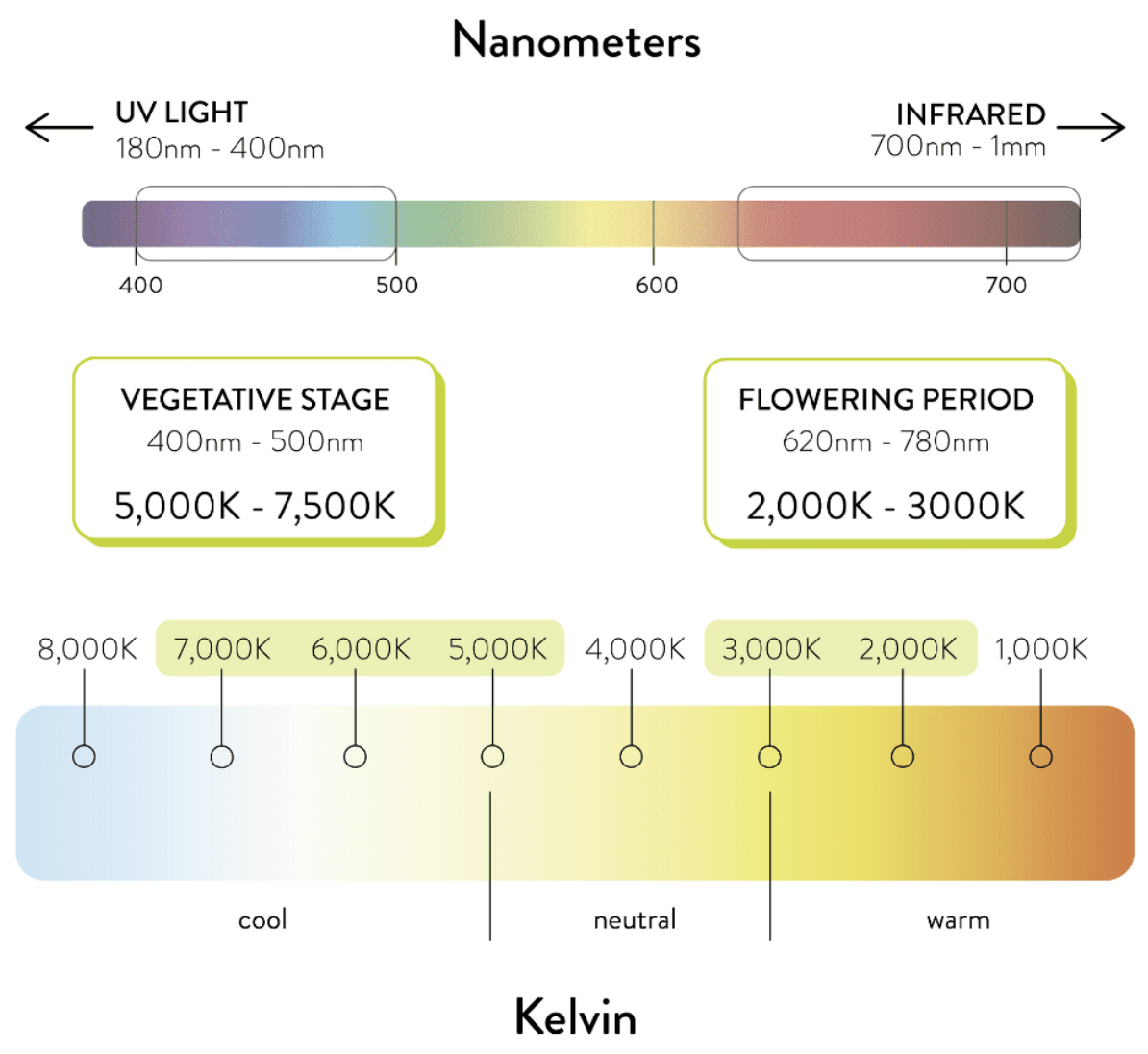
Plants detect wavelengths that include ultraviolet radiation (260–380 nm) and the visible part of the spectrum (380–740 nm) that includes PAR (400–700 nm), and far-red radiation (700–850 nm).
Plants grow best when they have visible light that ranges from 380 to 700 nanometers. In the plant science and horticultural world, we sometimes refer to this spectral range as photosynthetically active radiation – or PAR for short.
Blue light
Plants use violet and blue light waves, between 400 and 490nm, for vegetative growth.
Blue light stimulates increased amounts of cannabinoid concentrations, especially THC. In general, blue light increases compactness and makes the plants bushy. This is good because very tall, stretched plants cannot support large flower formations. HPS usually grow into tall, slender plants due to the lack of blue wavelengths in the spectrum. LEDs with blue light are therefore preferable, as chlorophyll absorbs blue light effectively and increases the plant’s overall yield. In the same way as UV, blue LED chips are more expensive. But blue light is essential for good development of the cannabis plant.
Red light
Red light is light between 580 and 700nm. This light is used by plants for reproductive growth.
A recently published article from the Czech Republic concluded that cannabis plants grown under a red and blue light spectrum have shorter internodes and a smaller leaf area than cannabis plants with a white light source [Lalge, 2017].
Ultraviolet light
Plants also use small amounts of ultraviolet light (UV). There are two types of ultraviolet light that are used:
- UV-A radiation : 315 to 400nm – can help plants produce robust plant growth.
- UV-B radiation : 280 to 315nm – in small amounts UV-B prevents fungal infections from attacking and spreading on an indoor plant. The light should be limited to short periods, as it can change the plant’s DNA and inhibit the plant’s ability to photosynthesize. Old research indicate that UV-B can increase THC in a plant.
Infrared radiation
Although infrared radiation (IR) is not necessary for photosynthesis, the radiation produces heat that signals that the plant needs to grow faster. IR also stimulates the growth of phytochromes, a photoreceptor that regulates plant development, leaf distribution, stem growth and reproductive growth.
Light spectrum for vegetative growth
The best color spectrum for vegetative growth is blue light, between 400 and 490nm (5000-7500K).
Light spectrum for flowering plants
The best light spectrum for flowering plants is red light between 610 to 700nm or 2000 to 3000K.
Impact of different kind of lightning
Plants grown under shaded daylight, filtered red and blue light have about the same THC content as plants grown in daylight, while the leaves from plants grown under dark conditions or filtered green light have a significantly lower THC content. This was the conclusion Mahlberg and Hemphill drew in their 1983 studies of the importance of light on the cannabis plant. Several studies have subsequently suggested that the blue and UV-A wavelengths have a positive impact on THC synthesis (NCBI, 2018).

These recommendations apply to cannabis lighting for the different stage of life cycle:
- Seedlings and cuttings: blue/white spectrum
- Vegetative growth: blue/white spectrum
- Flowering: red/orange spectrum
What is most effective? LED or HPS (high pressure sodium) light?
A regional sales manager in Canada for one of the world’s largest sellers of both HPS and LED horticultural lights estimates that 90% of Canadian cannabis growers use HPS lights during the flowering phase. A survey published in a leading cannabis trade journal reports that 62% of North American growers use HPS lights while 85% use lights that provide about the same or less light intensity as an HPS (CBT Staff, 2016).
This does not necessarily mean that HPS is the most efficient light. Studies show that the highest THC content (measured in the flowers) is found in plants grown with LED lights rather than HPS or fluorescent lights. This is probably because LED provides the plant with sufficient blue and UV-A wavelengths, while HPS does not have sufficient blue and UV-A rays. This is because HPS and fluorescent lights are older technologies that were originally developed for completely different purposes, such as street and office lighting and not plant lighting (NCBI, 2018).
Studies show that plants grown with LEDs become shorter and more compact than plants grown with HPS lights. The plants grown with HPS grow significantly taller and produce slightly higher flower yields than plants grown under LED lights (NCBI, 2018).
However, using HPS lights instead of LED lights results in a significant decrease in the THC concentration in the flower. Which means that the amount of CBD, THCV, and especially CBG is also reduced accordingly.
Most of the LED alternatives to HPS lights are marketed as “HPS replacements.” Which means that they should provide the same light intensity as an HPS light, while using significantly less electricity. Not uncommonly, you read e.g. “Equivalent to 1500W” when you read advertisements about an LED lamp, while the lamp itself only uses 40 watts.
Think about economy when choosing lighting
Although we all want the greatest possible light intensity to maximize the yield we get, this issue also has an economic side. The higher the light intensity you want, the more and stronger lamps you need. Somehow, the electricity bill increases – considerably if you don’t use LED lights, which use a fraction of the electricity compared to the effect they provide compared to an HPS light.
In USA, indoor cannabis agriculture has been classified as one of the “most energy intensive industries in the United States” (Warren GS, 2015). It is estimated that 1% of the total energy consumption in the United States goes to cannabis cultivation, and in top production states, such as California, the corresponding value is 3% (Mills, 2012). If your crop is to produce a profit, you must keep costs down by limiting electricity use. LED and solar panels are the solution for most people.
Full-spectrum or singel spectrum lighing
The most economical option is to choose a full-spectrum lamp instead of betting on several single-spectrum lamps that cover different stages in the plant’s life cycle.
Most full-spectrum LED lights today have two modes: A growth and a flower mode. In growth mode, the plant receives only white and blue light, while it is additionally supplied with red light during flower mode.
LED is the best choise
Most growers today are moving away from traditional HID, HPS (high pressure sodium) and fluorescent T5 grow lights in favor of LED lights. LEDs use less electricity in relation to light intensity and emit less heat. This means that the lamp can be placed closer to the plant, while the need for cooling is reduced (Bioslighting).
Height above the plant
How many inches above the crown of your cannabis plant should you place your LED light? The answer depends on:
- The strength (in watts) of your LED lamp
- Where in the life cycle of your cannabis plant is
The following rule of thumb applies to how high above the plant you should place your LED light at different stages of the plant’s life cycle:
- Seedling stage – 24-36 inches
- Vegetative stage – 12-24 inches
- Flower stage – 18-24 inches
Sources:
- Bioslighting – https://bioslighting.com/led-grow-light-distance-chart/grow-lighting/
- NCBI, 2018 – https://www.ncbi.nlm.nih.gov/pmc/articles/PMC8489345/
- Lalge A, Cerny P, Trojan V, Vyhnanek T. The effects of red, blue and white light on the growth and development of Cannabis sativa L. Mendel Net. 2017 Nov;:pp 646–651. [Google Scholar]
- Warren GS. Regulating pot to save the polar bear: energy and climate impacts of the marijuana industry. Columbia J Environ Law. 2015;40:385.
- Mills E. The carbon footprint of indoor cannabis production. Energy Policy. 2012;46:58–67.

